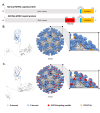Development of chimeric MrNV virus-like particles capable of binding to SARS-CoV-2-susceptible cells and reducing infection by pseudovirus variants
- PMID: 39732908
- PMCID: PMC11682422
- DOI: 10.1038/s41598-024-83024-z
Development of chimeric MrNV virus-like particles capable of binding to SARS-CoV-2-susceptible cells and reducing infection by pseudovirus variants
Abstract
SARS-CoV-2, the cause of COVID-19, primarily targets lung tissue, leading to pneumonia and lung injury. The spike protein of this virus binds to the common receptor on susceptible tissues and cells called the angiotensin-converting enzyme-2 (ACE2) of the angiotensin (ANG) system. In this study, we produced chimeric Macrobrachium rosenbergii nodavirus virus-like particles, presenting a short peptide ligand (ACE2tp), based on angiotensin-II (ANG II), on their outer surfaces to allow them to specifically bind to ACE2-overexpressing cells called ACE2tp-MrNV-VLPs. Replacing the ACE2tp at the protruding domains (P-domain) of the MrNV capsid proteins did not affect their normal assembly into icosahedral VLPs. The presentation of the ACE2tp on the P-domains significantly improved the binding and internalization of ACE2tp-MrNV-VLPs to hACE2-overexpressing HEK293T cells in a concentration-dependent manner. Furthermore, ACE2tp-MrNV-VLPs exhibited the ability to block the binding and infection of SARS-CoV-2 pseudovirus variants, including Wuhan, BA.2 Omicron, and Delta subtypes. Our results suggest that chimeric ACE2tp-MrNV-VLPs can serve as a blocking agent against various SARS-CoV-2 mutated variants and could also potentially serve as target-specific nano-containers to carry therapeutic agents to combat SARS-CoV-2 infections in the future.
Keywords: Macrobrachium rosenbergii nodavirus (MrNV); Genetic modification; Nanotechnology; Recombinant capsid protein; SARS-CoV-2; Virus-like particle.
© 2024. The Author(s).
Conflict of interest statement
Declarations. Competing interests: The authors declare no competing interests.
Figures






References
Publication types
MeSH terms
Substances
Supplementary concepts
Grants and funding
- N41A650111/National Research Council of Thailand (NRCT)
- N41A650111/National Research Council of Thailand (NRCT)
- RGNS 64-213/The Research Grant for New Scholar from the Office of the Permanent Secretary, Ministry of Higher Education, Science, Research and Innovation, Thailand
- RGNS 64-163/The Research Grant for New Scholar from the Office of the Permanent Secretary, Ministry of Higher Education, Science, Research and Innovation, Thailand
- 2560URMS0719/The Faculty of Medicine, Srinakharinwirot University Research Grants
LinkOut - more resources
Full Text Sources
Medical
Miscellaneous

